Rock River Valley Chapter of the Studebaker Drivers Club
Our Charter, Keeping the Studebaker Marque Alive
|
 |
|
|
 |
|
|
|
|
Preamble
The
information provided here is taken from Turning Wheel articles
written by Fred K. Fox. The text is rewritten to include some of my
own observations, ideas and interpretations of what I read. The
charts are for the most part rearranged reproduction of information
found in those issues. Any error in translation of the TW
information is the total fault of the author of this page. Please
feel free to point out any error you might find or to suggest
additional information you think might be helpful. Use the “Contact
Us” page from this website.
Disclaimer:
This page is not intended to be a complete reproduction of the work
Fred has done and I would encourage you to seek out copies of his
many TW article on GT Hawks as they contain a significant amount of
detailed information way to detailed for me to present here.
Quick GT Hawk front view ID markers, for detailed information about each year click the links below
|
|
|
|
|
|
|
|
|
Simple grille with a square pattern and no grille emblem. Side horizontal signal lights |
Grille has horizonal bars with a rectangular pattern. A Red, White, and Blue emblem. Round amber signal lights with clear bulbs at the ends of mesh background side grilles. |
Same grille pattern, but the horizontal bars are recessed and painted flat black. New center Gold Hawk emblem. New circle "S" hood ornament. |
General Restoration Information:
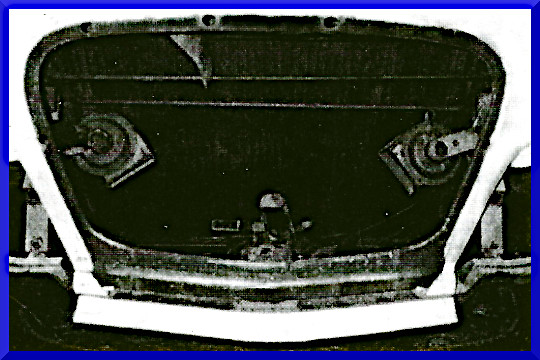 Note in the photo's above that both the 1962 and 1963 body color (White) is showing through the grille. All 1963, 1964 and most 1962 GT Hawks should have had the area behind the grille painted flat black as shown in the photo of a 1962 GT Hawk at the left.
Except for a few early 1962 GT Hawks, all 1962, 1963, and 1964 GT Hawks should have the inner portion of the air intake under the bumper painted a low luster black. The outer portions should be body color. The lower hood locking mechanism was also painted low luster black.
In looking at many photo's of GT Hawks, I noticed that many do not have front bumper guards. Others have them closer to the center, then others (1963 photo above) show them further out. I wondered about this, and this is what my research has uncovered. All three years the front bumpers were optional equipment. Item No. 68 in 1962 & 1963 and 71 in 1964. In close examination of the 1963 front above I discovered that there were no holes in the bumper where factory installed bumper guards would have been mounted, thus these must have been dealer installed or added by one of it's owners. Some information I picked up on the SDC forum indicated that front bumper guards were optional, that factory installed bumpers were inboard and dealer installed were outboard as there were no bumper holes to install them inboard. If you have any thoughts on this let me know using our "Contact Us" page on this site.
The wheel color on all GT Hawks (all years) was Pebble Sand on off-white color. Only two styles of exterior mirrors were offered for 1962 to 1964 GT Hawks, Stratoline (AC-2918) and Strato-Vue (AC-3188). The correct radiator and heater hose clamps are the spring wire type, except for the lower radiator hose clamp on the water manifold which was the flat metal type with the small screw and nut.
 All GT Hawks are equipped with 289 cubic inch V8's. In April of 1962 the full flow oil filter system was adopted. Duel exhaust and finned brake drums were standard equipment. The engine block, heads, pan, air cleaner 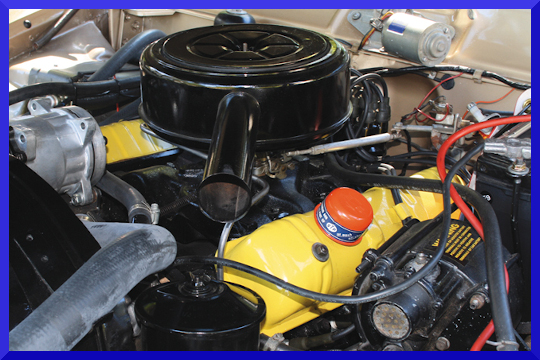 canister, pulleys, power brake unit, power steering unit, and electrical components (except alternator) were black. The valve covers and automatic transmission dip stick handle were painted yellow. The oil filler cap (or caps), fan and the oil dip stick handle were painted orange. The air conditioning compressor was natural metal color. STP decals are found on the oil filler caps (breather caps). The Avanti Jet Thrust engines were the same as above, except the valve covers, oil dip stick handle, air cleaner canister and R2 air inlet were chrome. R2 superchargers were Orange from the factory and black if rebuilt by Paxton. The R3 & R4 engines blocks, heads and pans were red, none were factory installed in any GT Hawks. Any 1963 or 1964 GT Hawk would be correct if equipped with the Avanti dress up kit AC-3421, which included chrome valve covers, oil breather caps and dip stick handle. The left photo is from an early (not full flow oil filter) 1962 GT Hawk engine and the right photo is from a 1963 (full flow oil filter) GT Hawk engine.
Not sure about the 1962 engine valve cover decal, but the 1963 engine STP decals are correct.
Grand
Turismo Hawk History 1962 to 1964
Current
Status:
Recent
history for GT Hawks indicate that while the early Hawks are going
down in value, the GT Hawks are in fact getting more expensive to
purchase. The probable causes might be that there were far fewer of
them made, especially 1964. The GT Hawk production started October
30th
1961 and ended in December 20th
1963
(64V-20197). In addition, these cars had a lot more of the driving comforts
available, like power steering, power brakes, front disc brakes (mid
1963), factory air conditioning and power seats.
The
Birth:
The
GT Hawk styling is done by Brooks Stevens Design. A lot of the work
on the GT project was done by Gordon Kelly, Stevens design department
director, but Stevens was deeply involved in the project, acting as
liaison between his company and Studebaker's design chief, Randy
Faurot1. The the project is given to Stevens by
then Studebaker President Sherwood Egbert, with a nearly non-existent
budget and very short lead time. Stevens is going for the
European-inspired, clean look.
Foot
Note1: TW March 2008
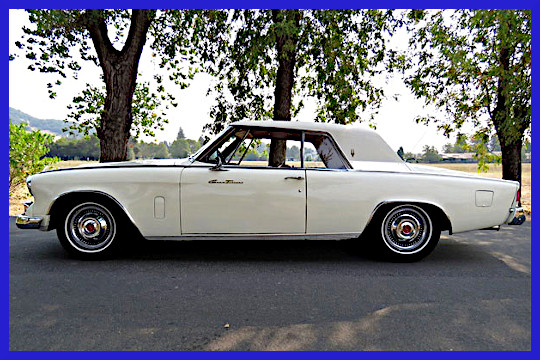 The exterior. The exterior. The
hood from the older Hawk's remained (for 1962 only) minis the chrome
air scoop, but retaining the raised area. However, a new much
lighter front grille that closely resembled that of a Mercedes-Benz is
added. The Gran Turismo would draw on American influences as well,
with a roof line that looks heavily inspired by the Ford Thunderbird. A chrome edge that runs from front to rear, at the top of the
bodywork, similar to that on the contemporary 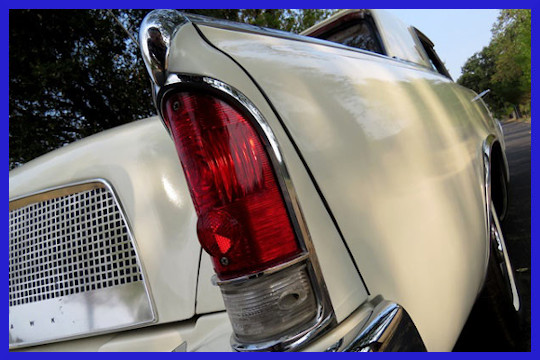 Lincoln Continental. The new taillights look like they may also have been borrowed from
Lincoln. The deck lid is given a faux "grille" overlay (to
hide the grooves of 1956-61 deck lid), 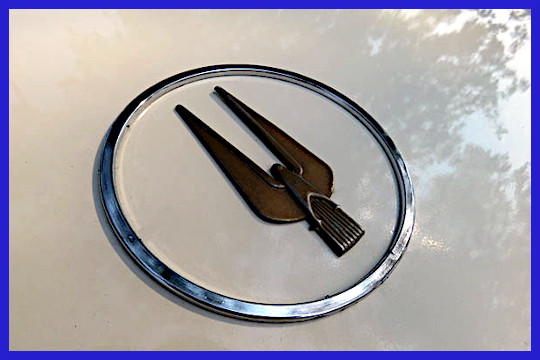 something similar is seen on
the rear of the Lincoln Continental. The rear window is nearly flat
and recessed. 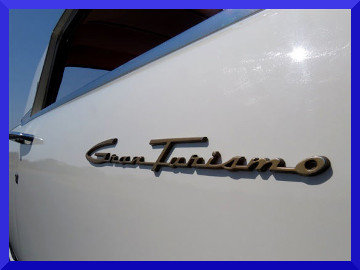 New nameplates and emblems, along with a new grooved
rocker panel molding, complete the changes. After a three year
hiatus, the GT would come back as a hardtop. Stevens's extensive yet
inexpensive modifications to the body completely removed 1950s-style
tail fins and body side trim of past Hawks, creating that clean
luxury look still in high demand today.
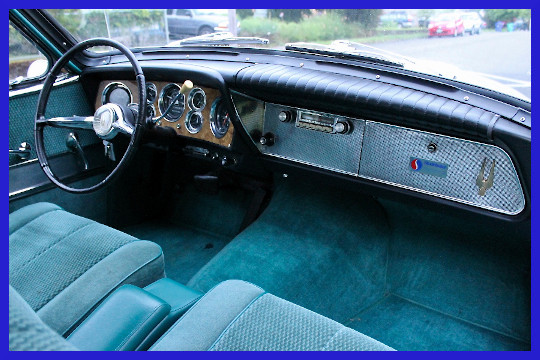 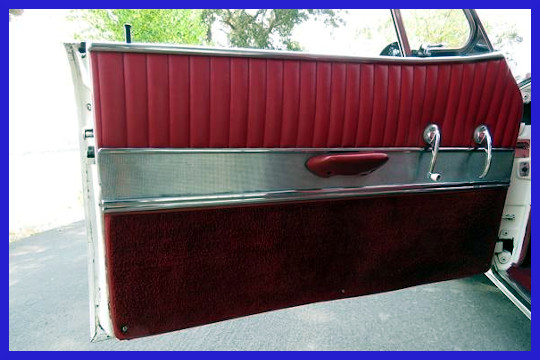 Stevens new interior, with a modern instrument panel, could be ordered with a
full complement of large, easy-to-read gauges, in the correct
driver's line of sight. The gauge portion of the dash is a three
plane affair with wood grain background. A new metal overlay would
cover the rest of the dash. The top 2/3rd's of the dash was
padded to serve as a crash pad. Door panels have vertical vinyl
pleats on the top, a center metal panel and carpet on the bottom. This treatment continues on into the back seat panels. The GT
featured front bucket seats and a console, befitting a grand-touring
car. All the 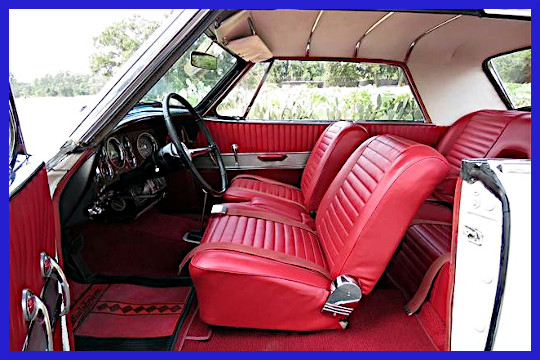 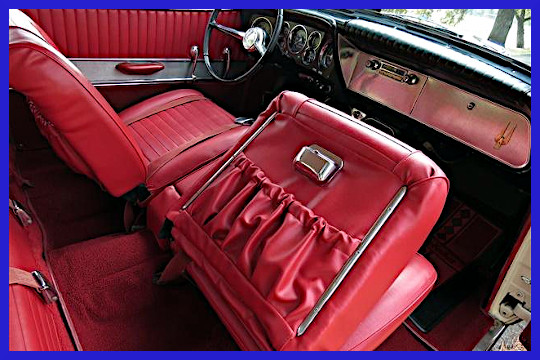 seats were upholstered in either cloth and vinyl or
all-pleated vinyl. Sadly, the 62's vinyl was of very poor quality
and quickly cracked along the pleats. It doubtful any 1962 GT Hawk
exists today with usable original upholstery. 1962 GT Hawks were the only year the seat pleats were horizonal.
Mechanically
the GT Hawk remained very similar to it's inheritance. The 289 cu.
in. V8 engine is used, along with a Flight-O-Matic, manual four
speed, or standard three-speed transmission. The manual three-speed
was available with the optional overdrive. The chassis was very
similar to the 1961 Hawk. The greatest 1962 mechanical change would
be a mid-year change making the 289 a full flow oil filter engine.
Tells:
From
the front, small rectangular signal/running lights are seen in the
two small side grilles. The surrounds should be painted body color,
many of the 1962 GT seen today have chromed surrounds which are not
correct, but look nice. This is the only year, that there would be
no emblem on center grille and the grille pattern is simple series of
squares.
From
the side, “Gran Truismo” door badges are present, without the
later years red/white/blue badges. For most of the year, the
standard full-wheel covers have a black scallops on the outer edge,
with a black lazy “S” in the center on a red center back ground. The plastic spears on the front fender are about twice as high as the
ones used on the next two years would be, and are not back-lit.
From
the rear, the faux "grille" overlay checkered pattern is
painted black, while the smooth area containing the script
“Studebaker Hawk” is not painted. The deck lid badge is a chrome
circle with a gold Hawk in the center. The new tail lights have body
painted housing with chrome trim around the lens. Most 1962 GT Hawk,
if equipped with a radio have a center mounted rear deck-lid
antenna. This was because the new trim on the front fenders would
not allow for a cowl mounted antenna. This issue was addressed late
in the model year when a cowl mount antenna was designed, so 1962 GT
Hawks are the most likely ones to have a rear antenna.
From
the interior, 1962 would be the only GT with horizontal seat insert
pleats. A metal dash overlay is seen on the right 2/3rds of the
dash, although some early 1963 models would also feature this overlay
until the inventory is used up.
Restoration:
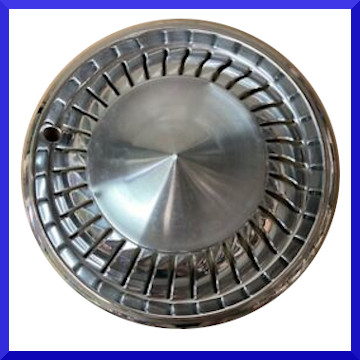  Hubcaps: Hubcaps: In 1962 there were no less then four different hubcaps that could be
correct. Initially the hubcaps used were exactly the same as 1961
Hawks and Larks, black “S” on chrome center with black peripheral
scallops (AC-3071). Shortly after production began they switched to
red centers (AC-3276). Two optional set were available at extra
cost, Air-Flo (AC-3277) or Air-Strut (AC-3280). Both (photos left & right) seem
to be fairly rare.
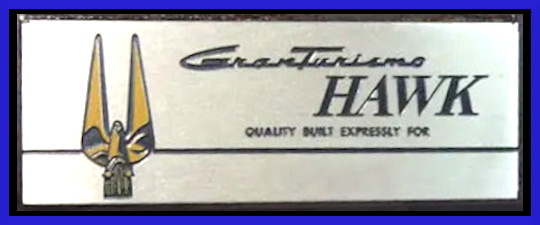
Sidebar: In
February of 1962 Studebaker began giving out personalized dash panel nameplates to each new Hawk owner. This practice would continue (if requested) on all GT Hawks until the end of production in Dec. 1963.
The photo shown on the left is from a 1963 GT, the name has been removed. We do not have an image of a 1962 name plate, but expect they were all the same.
|
1962
Gran Truismo Hawk Seat Upholstery |
|
Cloth
and Vinyl |
|
Code |
Color |
|
BL |
Blue
Vinyl & Cloth |
|
GR |
Green
Vinyl & Cloth |
|
TA |
Taupe
Vinyl & Cloth |
|
All
Vinyl |
|
Code |
Color |
|
BKV |
Black
Vinyl with Ivory Vinyl Insert |
|
TVA |
Taupe
Vinyl |
|
BLV |
Blue
Vinyl |
|
RDV |
Red
Vinyl |
|
GRV |
Green
Vinyl |
|
STV |
Saddle
Tan Vinyl |
|
Regal
cloth and vinyl was standard. Regal all vinyl was optional for an
extra $31.74. Initially black vinyl was only available with Ivory
vinyl insert, while all other colors came with matching inserts.
At mid-year, Black could be ordered with Black inserts. |
|
1962
Gran Truismo Hawk External Paint Color |
|
Code |
Color |
Code |
Color |
|
6210 |
Black
Velvet |
6,214 |
Metallic
Silver |
|
6211 |
Ermine
White |
6,215 |
Desert
Tan |
|
6212 |
Riviera
Blue |
6,216 |
Blaze
Red |
|
6213 |
Metallic
Green |
6,217 |
Metallic
Brown |
|
All
1962 GT Hawks were only offered in solid colors. Some dealers and
many owners created two-tones by painting the top a different
color. Engine colors: Black block, heads, pan and air cleaner
with yellow valve covers and orange breather cap and fan. |
|
1962
Gran Truismo Hawk Specifications Models 62V-K6 and 62S-K61 |
|
Model |
Engine |
Price |
Weight |
|
62V-K6 |
V8 |
$3,095.00 |
3,230 |
|
62S-K6 |
Six |
? |
? |
|
Engines |
289 |
2591 |
1701 |
|
Type |
OHV
V8 |
OHV
V8 |
OHV
Six |
|
Bore
& Stroke |
3.56
x 3.62 |
3.56
x 3.25 |
3.0
x 4.0 |
|
Displacement
(cu. in.) |
289 |
259.2 |
169.6 |
|
Horsepower |
210 |
180 |
112 |
|
Horsepower
w/4bbl |
225 |
195 |
N/A |
|
Compression
Ratio |
8.5:1 |
8.5:1 |
8.25:1 |
|
Carburetor |
Stromberg
WW |
Stromberg
WW |
Carter
AS |
|
Carburetor
4bbl |
Carter
WCFB |
Carter
WCFB |
N/A |
|
Wheel
Base 120.5 inches – Fuel Tank 18 gallons – Tires (US) 6.70 x
15 |
|
1Models
with 259 V8's or 170 sixes were only offered for sale outside the
US |
|
1962
Gran Truismo Hawk Serial & Engine Numbers |
|
Starting
Serial Numbers |
62V |
62S1 |
|
|
US |
62V-1,001 |
62S-1,001 |
|
|
Canada |
62VC-1,001 |
62CS-1,001 |
|
|
Starting
Engine Serial Numbers |
|
|
289
V8 |
259
V81 |
170
Six1 |
|
US |
P-79,801 |
V-534,901 |
S-210,901 |
|
Canada |
PC-2,801 |
VC-19,601 |
SC-24,301 |
|
Ending
Engine Serial Numbers |
|
|
289
V8 |
259
V81 |
170
Six1 |
|
US |
P-93,600 |
V-566,600 |
S-261,200 |
|
Canada |
PC-3,400 |
VC-21,400 |
SC-29,700 |
|
1Models
with 259 V8's or 170 sixes were only offered for sale outside the
US |
|
1962
Gran Truismo Hawk Production |
|
South
Bend |
Canada |
Export |
Total |
|
7,842 |
546 |
947 |
9,335 |
|
All
domestic 1962 GT Hawks are fitted with 289 V8's. Some exports had
either 170 sixes or 259 V8's |
Tells:
From
the front, new mesh side grilles, new headlight rims are a
combination of paint and chrome with grooves on the inside. The
grille now has five prominent horizontal bars and a new
red/white/blue grille badge is located on the lower drivers.
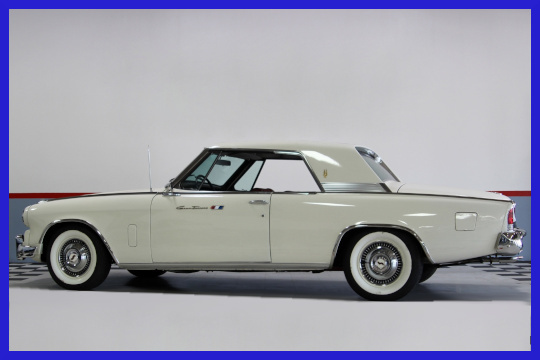 From
the side, “Gran Truismo” door badges are present, but now have
new red/white/blue badges behind the script. The standard
full-wheel covers are exactly the same as last years, except the
center back ground is silver rather then red (AC-3405). The plastic
spears on the front fender are about half as high as the ones seen
last year and are back-lit when the headlights are turned on.
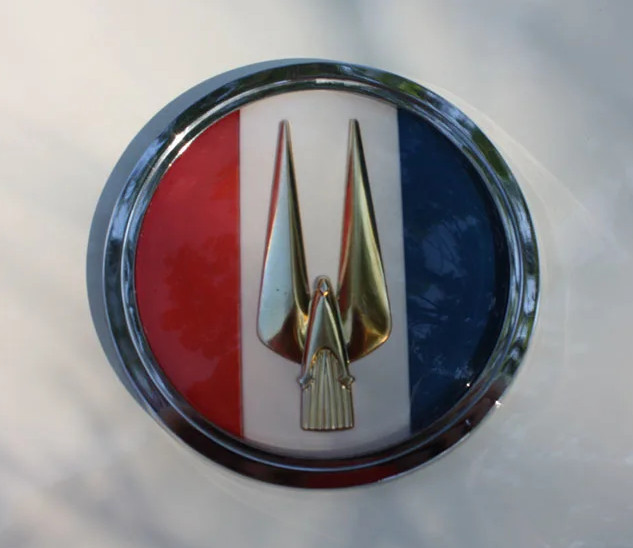 From
the back, there is a new red/white/blue deck-lid badge with a gold
hawk in the center. 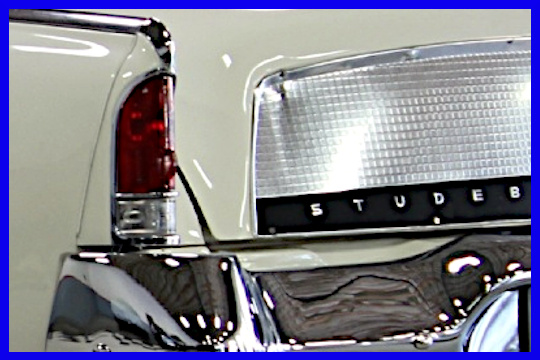
The overlay is modified, the “Studebaker Hawk”
lettering is much larger and the smooth background is painted black. The waffle pattern squares are painted silver. The rear deck-lid
radio antenna is an option, but seems most buyers opted for the new
available cowl mount.
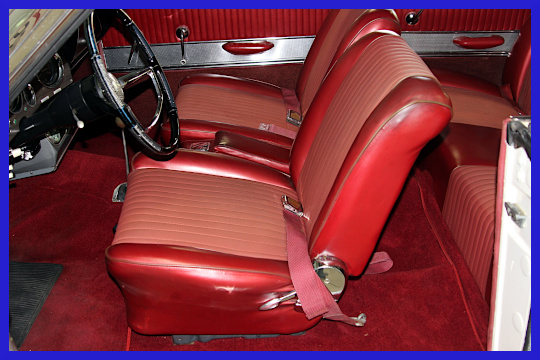 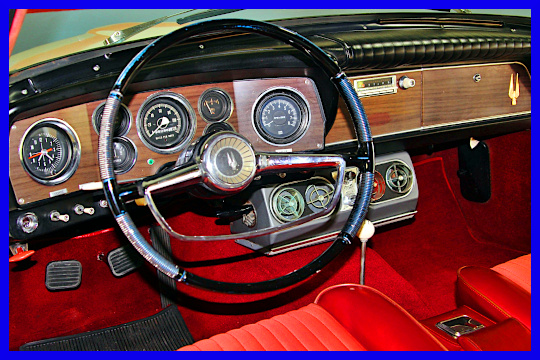 From
the interior, the seat insert pleats are now vertical. The metal dash
overlay from last year are seen on early cars, after 63V-K6-1328 this
portion of the dash would have woodgrain overlays. (See photo on the right) A black steering wheel with a new horn ring is introduced. 1962 GT Hawks did not have a horn ring.
Mechanical changes for the 1963 GT Hawks, the generator is replaced with an
alternator and the drum brakes were again self-adjusting, last done
in 1953. Hawks equipped with disk brakes (mid-year) would have a
brake reservoir attached to the firewall, but would not use the duel
master cylinder introduced this year on the Larks.
Restoration:
Two
of the most frequently discussed restoration issues, other then the
dash features above, involve the red/white/blue door badges and the
front signal lights.
The
colors given here are from left to right as you face the badge. A
red/white/blue badge with gold base should be placed on the drivers
side, while a blue/white/red badge with gold base should be placed on
the passenger side. On 1964 GT Hawks, the badges would be
red/white/blue on a chrome base on both sides. Most of the photo's I
have seen of 64's follow the 1963 pattern, the reason is unknown but
supposedly incorrect.
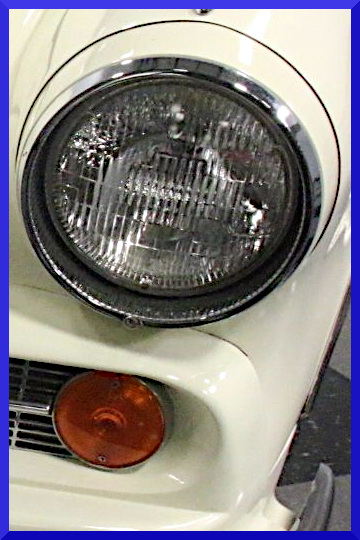 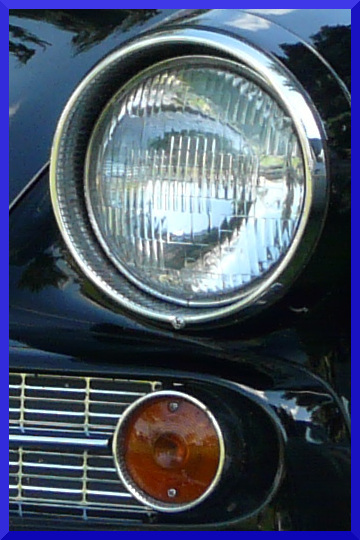 The
early 1963 parking/turn signal lights (left photo) had flush mounted amber lens
(part #1353542) with clear bulbs. At serial number 63V-11587 (right photo) the
lens housing changed, having grooves on the inner sides similar to
the the headlight rims and a new recessed amber lens (part # 1355019)
with clear bulbs are used. In 1964 the lens would change to clear
with an amber bulb. Clear lens were used on 1963 exports, but the
best information indicates that all 1963 GT Hawks should have amber
lens with clear bulbs. These photo's also show the new headlight rims which are a combination of chrome and paint with the interior grooves.
Side
Bar: The side grille are are now for looks only as no air can go
through them. They are a newly designed shape and thus required a
modified hood, so 1963 and 1964 GT Hawks cannot use the prior Hawk
hoods (1956 – 1962).
On the grille badges on the right, note the "Stars" in the Red section, they would not be there for the 1964 grille badges.
The following
chart lists the items which came standard with these packages.
|
Super
Hawk Standard Package Items |
|
R1 or R2
Jet Thrust engine. |
Front seat
belts. |
|
Side and
grille identification plates & emblems. |
160 mph
speedometer. |
|
Twin
Traction. |
Disc
brakes (front) |
|
Heavy duty
springs, front and back. |
Heavy duty
shocks, front and back. |
|
Rear axle
radius rods. |
Rear
stabilizer bar. |
|
4-speed or
Power-shift transmission. |
|
|
The
viscous fan drive, larger radiator, tachometer, and chrome engine
parts came standard with Jet Thrust engines. The R2 package could
not be had with air conditioning because of the supercharger.
Super Red Metallic (P6325) exterior paint was a special color
reserved for use on Super Hawks and Super Lark models only. |
|
1963
Gran Truismo Hawk Seat Upholstery |
|
Cloth
and Vinyl |
|
Code |
Insert |
Capping |
|
624
BC |
Blue
Nylon Cloth |
Blue
Vinyl |
|
634
GC |
Green
Nylon Cloth |
Green
Vinyl |
|
644
CC |
Chestnut
Nylon Cloth |
Chestnut
Vinyl |
|
654
RC |
Red
Nylon Nylon Cloth |
Red
Vinyl |
|
All
Vinyl |
|
Code |
Insert |
Capping |
|
714
BKV |
White
Vinyl |
Black
Vinyl |
|
7141
BKV |
Black
Vinyl |
Black
Vinyl |
|
724
BV |
White
Vinyl |
Blue
Vinyl |
|
7241
BV |
Blue
Vinyl |
Blue
Vinyl |
|
734
GV |
White
Vinyl |
Green
Vinyl |
|
7341
GV |
Green
Vinyl |
Green
Vinyl |
|
744
CV |
White
Vinyl |
Chestnut
Vinyl |
|
7441
CV |
Chestnut
Vinyl |
Chestnut
Vinyl |
|
754
RV |
White
Vinyl |
Red
Vinyl |
|
7541
RV |
Red
Vinyl |
Red
Vinyl |
|
764
TV |
White
Vinyl |
Tan
Vinyl |
|
7641
TV |
Tan
Vinyl |
Tan
Vinyl |
|
|
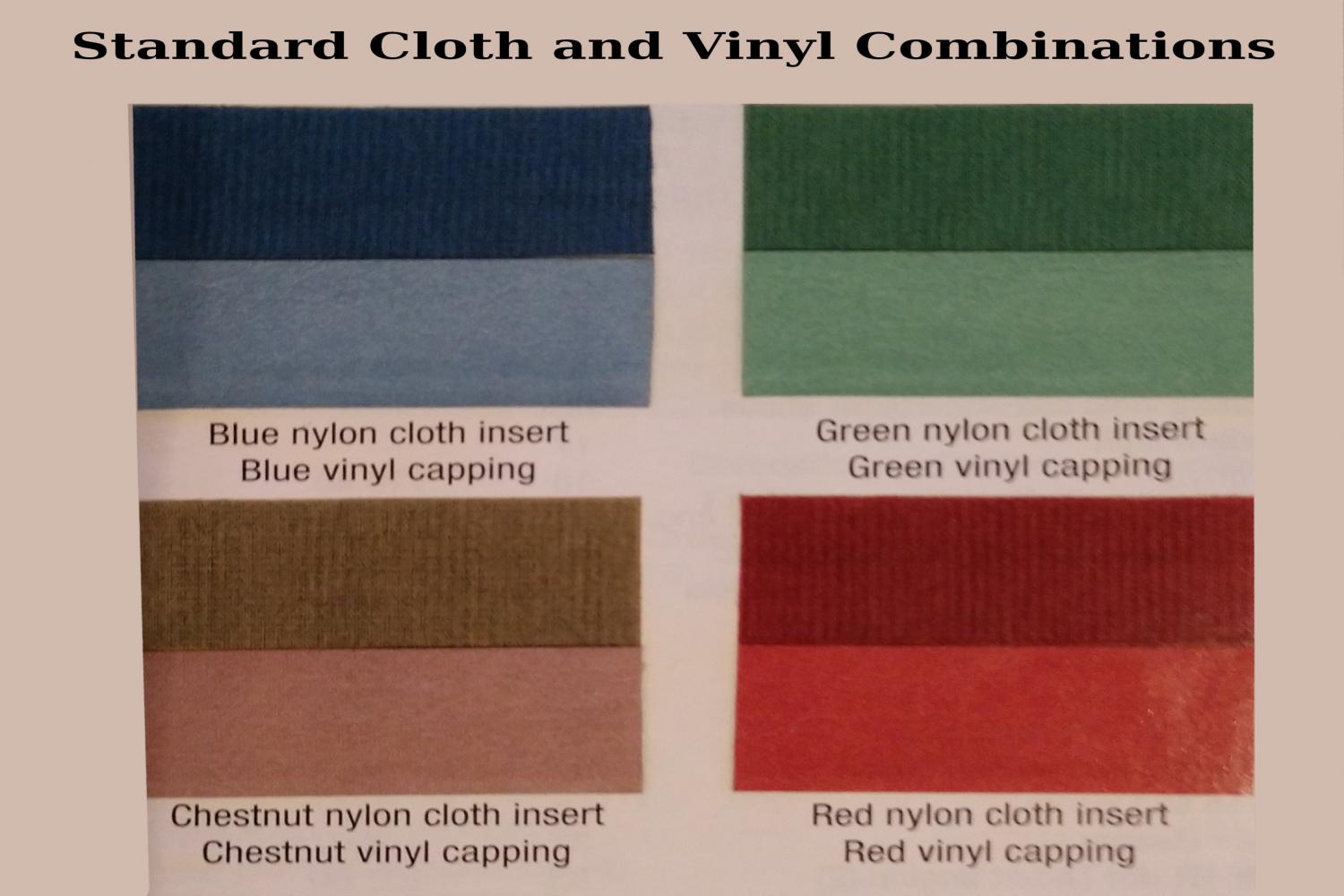 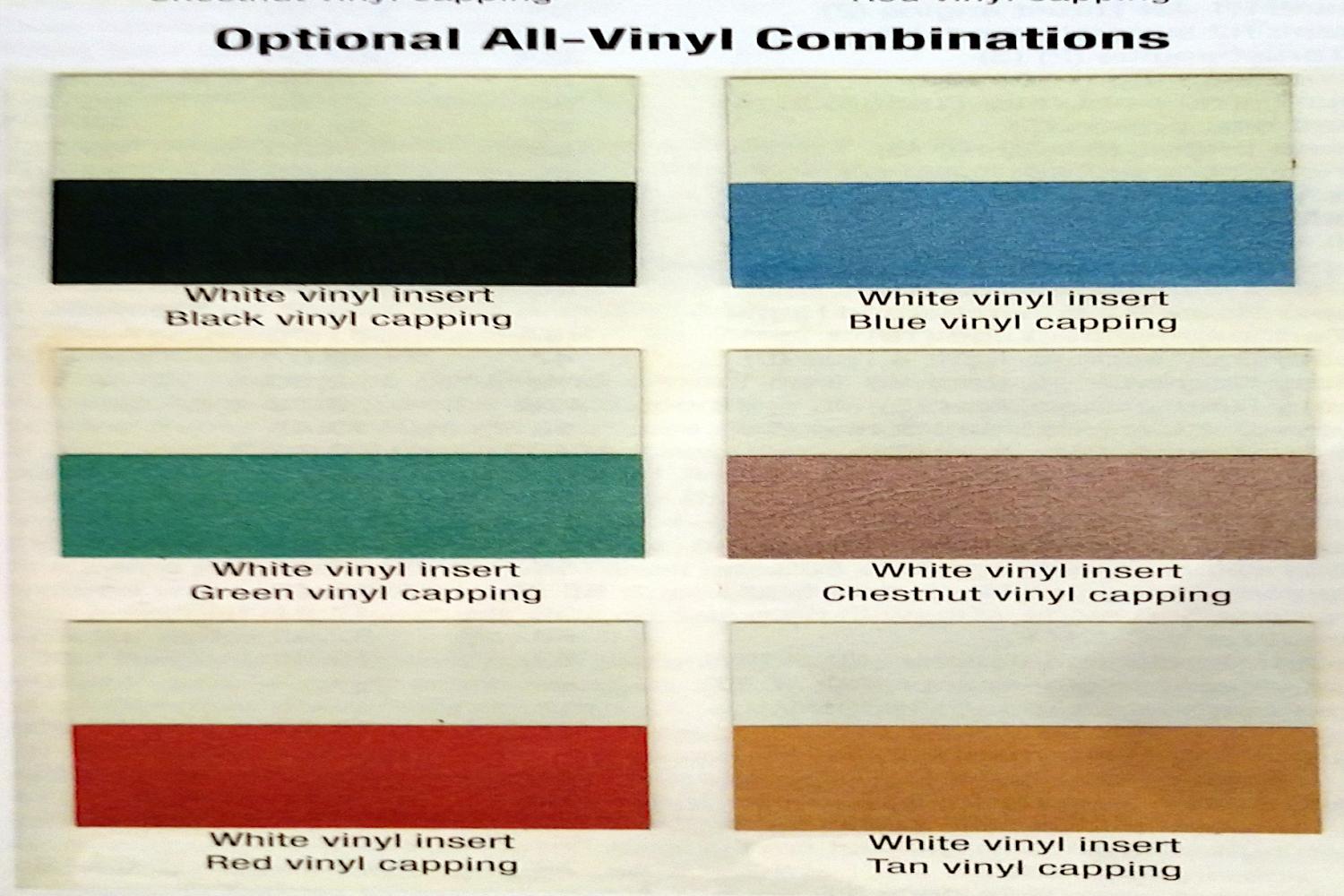
|
1963
Gran Truismo Hawk External Paint Color |
|
Code |
Color |
Code |
Color |
|
6310 |
Black
Velvet |
6316 |
Regal
Red |
|
6311 |
Ermine
White |
6317 |
Rose
Mist Metallic |
|
6312 |
Blue
Mist Metallic |
63251 |
Super
Red Metallic |
|
6313 |
Green
Mist Metallic |
63262 |
Seaspray
Green |
|
6314 |
Silver
Mist Metallic |
63272 |
Seabeach
Sand |
|
6315 |
Champagne
Gold Metallic |
|
|
|
1Only
offered on Hawks and Larks with High Performance Packages
2Spring
Colors
No
two-tones or vinyl covered tops were offered from the factory
during the 1963 model year. |
|
1963
Gran Truismo Hawk Specifications Models 63V-K6 and 63S-K61 |
|
Model |
Engine |
Price |
Weight |
|
|
63V-K6 |
V8 |
$3,095.00 |
3,280 |
|
R1
Super Hawk |
V8-JT |
$3,466.70 |
? |
These cars have the complete High Performance Package. |
|
R2
Super Hawk |
V8-JTS |
$3,676.70 |
? |
|
Engines |
1701 |
2591 |
289 |
R1
289 |
R2
289 |
|
Type |
OHV
Six |
OHV
V8 |
OHV
V8 |
OHV
V8 |
OHV
V8 |
|
Bore
& Stroke |
3.0
x 4.0 |
3.56
x 3.25 |
3.56
x 3.62 |
3.56
x 3.62 |
3.56
x 3.62 |
|
Displacement
(c. i.) |
169.6 |
259.2 |
289 |
289 |
289 |
|
Horsepower
w/2-bbl |
112@4500 |
180@4500 |
210@4500 |
N/A |
N/A |
|
Horsepower
w/4-bbl |
N/A |
195@4500 |
225@4500 |
240@5000 |
2289@4800 |
|
Compression
Ratio |
8.25:1 |
8.5:1 |
8.5:1 |
10.25:1 |
9.0:1 |
|
Carburetor
2-bbl |
Carter
AS |
Stromberg
WW |
Stromberg
WW |
N/A |
N/A |
|
Carburetor
4-bbl |
N/A |
Carter
AFB |
Carter
AFB |
Carter
AFB |
Carter
AFB |
|
Wheel
Base 120.5 inches – Fuel Tank 18 gallons – Tires (US) 6.70 x
15
1Models
with 259 V8's or 170 sixes were only offered for sale outside
North America
2Supercharged |
|
1963
Gran Truismo Hawk Serial & Engine Numbers |
|
Starting
Serial Numbers |
63
289 V8's |
63 Sixes1 |
No sixes were manufactured in Canada and the ones manufactured in the US (South Bend) were for export only.
|
|
US |
63V-1,001 |
63S-1,001 |
|
Canada |
63VC-1,001 |
None |
|
Starting
Engine Serial Numbers |
|
|
170
Six1 |
259
V81 |
289
V8 |
289
V8 R1 |
289
V8 R2 |
|
US |
S-261,201 |
V-566,601 |
P-93,601 |
JT-1,001 |
JTS-1,001 |
|
Canada |
|
None |
PC-3,401 |
JTC-1,0012 |
JTSC-1,0013 |
|
1Models
with 259 V8's or 170 S's, if produced, were only offered for sale
outside the US.
2One
production source indicates that no R1 powered Hawk & Larks
were made in Canada.
3The
starting serial numbers for R2 Canadian engines may have been
JTSC-1,101 on 1,001 |
|
1963
Gran Truismo Hawk Production |
|
South
Bend |
Canada |
Export |
Total |
|
3,649 |
3601 |
625 |
4,634 |
|
1A
hand written “Summery” sheet from Canada gives a figure of
363. |
|
Avanti
Powered 1963 GT Hawks1 (South Bend) |
|
Engine |
Total |
Super
Hawks2 |
|
Jet
Thrust R1 |
369 |
13 |
|
Jet
Thrust R2 |
278 |
44 |
|
1The
number of Avanti powered Hawks listed above are included in the
3,649 number above.
2The
Super Hawks are included in the total number (369) & (278)
above. |
|
Avanti
Powered 1963 GT Hawks1 (Canada) |
|
18
R2 Hawks were assembled in Canada, none were Super Hawks. Eleven
of them had Flight-o-Matics and seven had four-speed manual
transmissions. Sidebar: The number of sixes or 259 V8's powered
GT Hawks is unknown, but we do know that what ever may have been
manufactured was sold outside North America. |
Tells:
From
the front, the embossed Hawk on the top of the grille surround is
removed in favor of a stand up circled "S" emblem (hood ornament). The
grille pattern is similar to 1963, but the vertical bars are slightly
recessed and painted flat black. There is a new central grille
emblem, a gold Hawk on a brushed chrome base. The side grilles,
actually slightly reshaped, now curve around toward the inner edge
and have no vertical component. The signal light lens are clear with
amber bulbs. The R series round grille badges are redesigned. The
surrounds and headlight rims are mounted with black rubber cushions
between them.
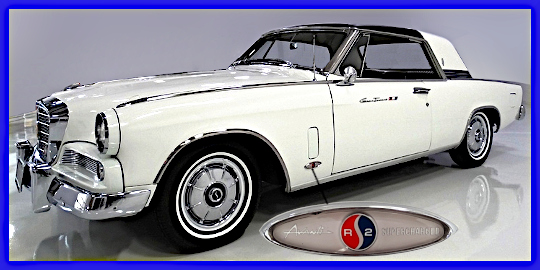 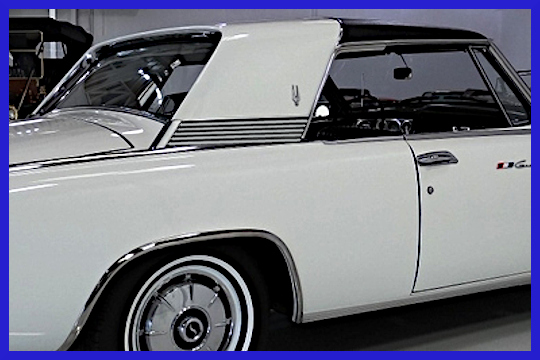 From
the side, the red/white/blue badges are on a chrome instead of gold
base. The horizontal molding on the “C” pillar has black paint
in the grooves. There are new full-wheel covers (AC-3155). The Hawk
“birds” and the “Gran Turismo” script have changed from gold
to chrome. R series fender badges have 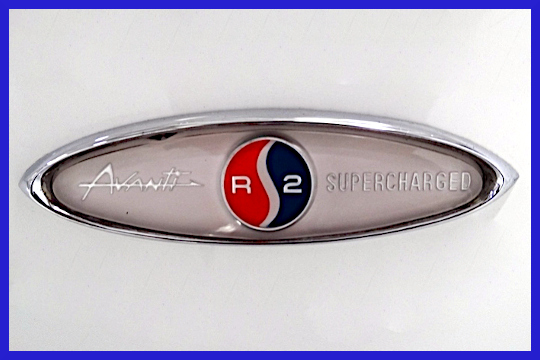 changed from rectangular to
oval.
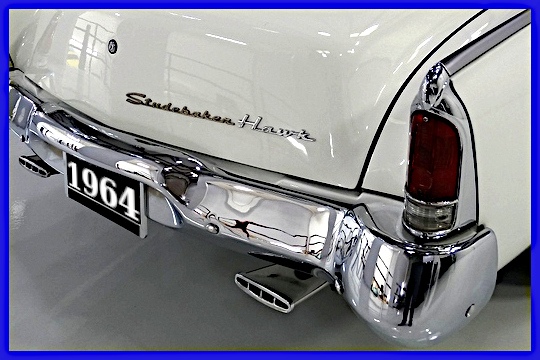 From
the rear, the faux metal over-lay is gone, there is a new smooth
deck-lid, finally 1956 to 1963 grooves are gone. This change
requires a new chrome “Studebaker Hawk” script for the new
deck-lid. The taillight housing are completely chrome plated.
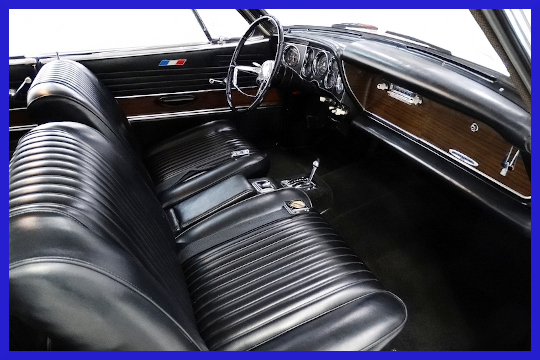 On
the interior, the pleats are removed from the upper dash crash pad. A new lower crash 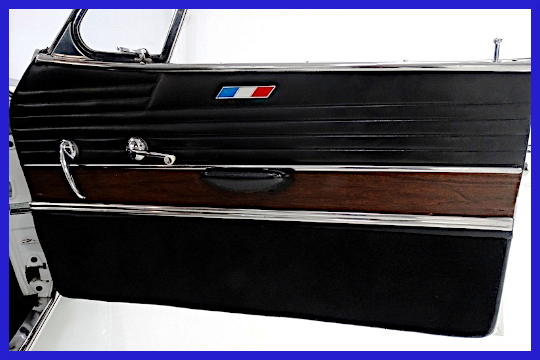 pad is added below the radio and glove box. The
chrome metal door inserts are replaced with wood grain panels, the
upper door pleats are horizontal instead of vertical and those
red/white/blue emblems seen on the outside of the doors are now on
the interior door panels as well. The background around the gauges
is black instead of wood grained and new chrome trim surrounds each
section of the three plain instrument panel.
Mechanical
changes were slim in 1964, most significant was the addition of R3 &
R4 packages, while available no factory R3 or R4 was sold. The badges
were produced and sometimes seen and added to R3 or R4 clones. However, several options were added for R1 & R2 packages, which
include transistor ignition system, exhaust headers and a heavy duty
competition clutch.
Restoration:
 One
of the unique features of the 1964 GT Hawk, was the optional new
black or white vinyl “Sports Roof” that could be added to the
front ½ of the roof. We don't know how many of this option was
purchased, but have one example in our club in Ron Bell's 1964 GT.
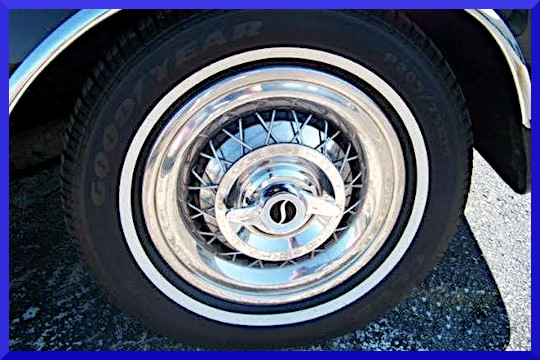 Besides
the new standard full-wheel covers (AC-3155) for 1964, the Air-Flo's
were discontinued, but the Aero-Strut style was still offered, as
well an a new wire spoke version. Halibrand “mag” wheels were
available from dealers. The Halibrand's have recently be made
available and I have seen them installed on a local 1964 Avanti.
|
1964
Gran Truismo Hawk Seat Upholstery |
|
Cloth
and Vinyl |
|
Code |
Cloth
Insert |
Capping |
|
824
BC |
Blue
Metallic Weave Cloth |
Blue
Vinyl |
|
834
GC |
Green
Metallic Weave Cloth |
Green
Vinyl |
|
844
BRC |
Chestnut
Metallic Weave Cloth |
Brown
Vinyl |
|
854
RC |
Red
Metallic Weave Cloth |
Red
Vinyl |
|
All
Vinyl |
|
Code |
Insert |
Capping |
|
914
BKV |
Black
Vinyl |
Black
Vinyl |
|
924
BV |
Blue
Vinyl |
Blue
Vinyl |
|
934
GV |
Green
Vinyl |
Green
Vinyl |
|
944
BRV |
Brown
Vinyl |
Brown
Vinyl |
|
954
RV |
Red
Vinyl |
Red
Vinyl |
|
Inserts
pleats run lengthwise. 1964 GT Hawk cloth or all vinyl seats are
offered only in solid colors. The all vinyl option cost was
$31.74. The cloth offered for 1964 GT Hawks is unique with the
addition of the silver threads in the cloth patterns. |
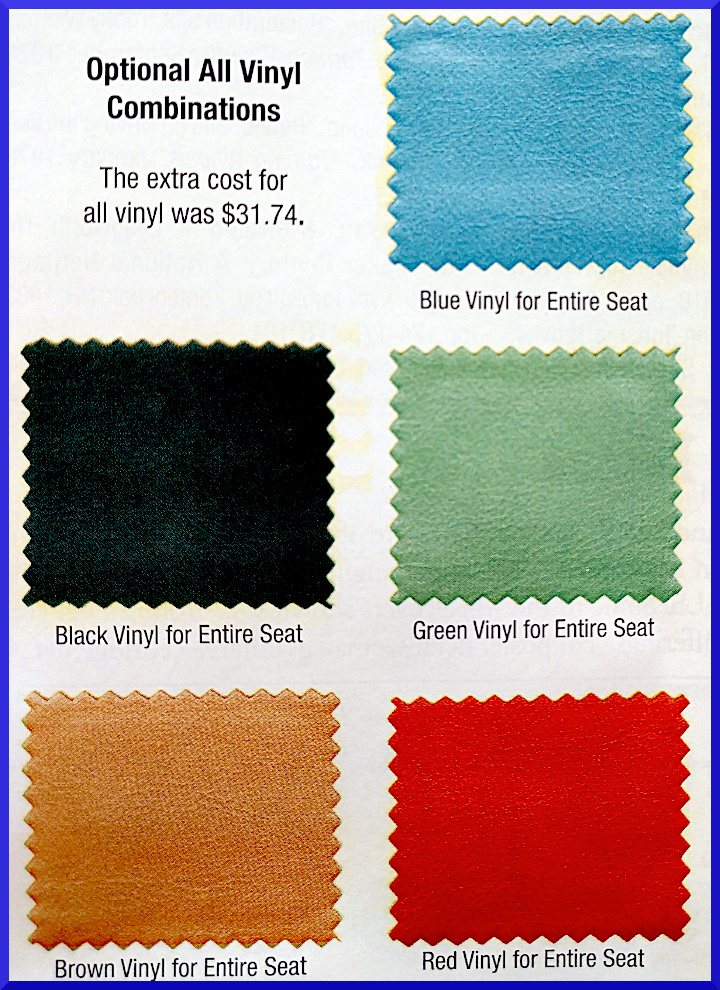 
|
1964
Gran Truismo Hawk Vinyl Sports Roof Option |
|
White
Vinyl Sports Roof |
|
Standard |
Optional |
|
Midnight
Black |
Astra
White |
|
Strato
Blue |
Laguna
Blue |
|
Jet
Green |
Horizon
Green |
|
Bordeaux
Red |
Moonlight
Silver |
|
Bermuda
Brown |
Golden
Sand |
|
Black
Vinyl Sports Roof |
|
Standard |
Optional |
|
Astra
White |
Midnight
Black |
|
Laguna
Blue |
Strato
Blue |
|
Horizon
Green |
Jet
Green |
|
Moonlight
Silver |
Bordeaux
Red |
|
Golden
Sand |
Bermuda
Brown |
|
The
vinyl Sports Roof option cost was $65.00 |
|
1964
Gran Truismo Hawk External Paint Color |
|
Code |
Color |
Code |
Color |
|
P6410 |
Midnight
Black |
P6415 |
Jet
Green Metallic |
|
P6411 |
Astra
White |
P6416 |
Moonlight
Silver Metallic |
|
P6412 |
Laguna
Blue Metallic |
P6417 |
Golden
Sand Metallic |
|
P6413 |
Strato
Blue Metallic |
P6418 |
Bordeaux
Red |
|
P6414 |
Horizon
Green Metallic |
P6419 |
Bermuda
Brown Metallic |
|
Wheels
on the outside were painted an off-white color called Pebble Sand.
Most if not all of the wheels were painted black on the inside.
No two-tones were offered from the factory during the 1964 model
year. Studebaker called their enamels “Sapphire-Luster Exterior
Finishes” and claimed that they never needed waxing. |
|
1964Gran
Truismo Hawk Specifications Models 64V-K6 and 64S-K61 |
|
Model |
Engine |
Price |
Weight |
|
|
63V-K6 |
V8 |
$2,958.00 |
3,280 |
|
R1
Super Hawk |
V8-JT |
$3,329.70 |
? |
These
are cars with the complete High Performance Packages. However
note that while the R3 & R4 were offered, none were built. |
|
R2
Super Hawk |
V8-JTS |
$3,539.70 |
? |
|
R3
Super Hawk |
|
$4,360.70 |
? |
|
R4
Super Hawk |
|
$4,220.70 |
? |
|
Engines |
1701 |
2591 |
289 |
R1
289 |
R2
2892 |
|
Type |
OHV
Six |
OHV
V8 |
OHV
V8 |
OHV
V8 |
OHV
V8 |
|
Bore
& Stroke |
3.0
x 4.0 |
3.56
x 3.25 |
3.56
x 3.62 |
3.56
x 3.62 |
3.56
x 3.62 |
|
Displacement
(CU) |
169.6 |
259.2 |
289 |
289 |
289 |
|
Horsepower
w/2-bbl |
112@4500 |
180@4500 |
210@4500 |
N/A |
N/A |
|
Horsepower
w/4-bbl |
N/A |
195@4500 |
225@4500 |
240@5000 |
2289@4800 |
|
Compression
Ratio |
8.25:1 |
8.5:1 |
8.5:1 |
10.25:1 |
9.0:1 |
|
Carburetor
2-bbl |
Carter
AS |
Stromberg
WW |
Stromberg
WW |
N/A |
N/A |
|
Carburetor
4-bbl |
N/A |
Carter
AFB |
Carter
AFB |
Carter
AFB |
Carter
AFB |
|
The
R3 & R4 engine specifications |
|
The
R3 & R4 displacement was 304.5 with a the bore at 3.65 inches
and the stroke at 3.62 inches. Both versions used the Carter AFB
4-bbl carburetor. Both engines used transigniter
(transistor)
ignition. The R3's compression ratio was 9.75:1, it was
Supercharged, and made 335 HP @ 5,350 rpm. The R4's compression
ratio was 12.0:1,Duel Carter AFB 4-bbl, and made 280 HP @ 5,000
rpm. There was a special edition R3 version with duel valve
springs and a high-output supercharger pulley set that was rated
at 400 HP @ 6,000 rpm. To the best information available no 1964
GT Hawks were manufactured or even ordered before the December
1963 South Bend production shutdown. |
|
Wheel
Base 120.5 inches – Fuel Tank 18 gallons – Tires (US) 6.70 x
15 – Cooling System 17 quarts (18 quarts with Climatizer) –
Oil Capacity 5 quarts (6 quarts with oil filter).
1Models
with 259 V8's or 170 sixes were only offered for sale outside
North America
2Supercharged |
|
1964
Gran Truismo Hawk Serial & Engine Numbers |
|
Starting
Serial Numbers |
63
289 V8's |
63Sixes1 |
|
|
US |
64V-1,001 |
64S-1,001 |
|
1964
Engine Identification Code |
|
Engine
Type |
S=170 |
V=259 |
P=289 |
JT=Jet
Thrust |
JTS=Jet
Thrust Supercharged |
|
Month
(The
letters I & L are not used) |
A=Jan. |
B=Feb. |
C=Mar. |
D=Apr. |
E=May |
F=June |
|
G=July |
H=Aug. |
J=Sept. |
K=Oct. |
M=Nov. |
N=Dec. |
|
Year |
3=1963 |
4=1964 |
|
Day
of Month |
A
two digit number representing the day. (12=12th day of
the month) |
|
Studebaker
adopted an all new engine numbering system in 1964. The first
Letters in the string will identify the engine type. The next
letter will identify the month built. The third number “3 or 4”
will identify what year, 1963 or 1964. The last two numbers will
represent the day of the month. In this system, any domestic
engine type built on the same day have the same engine number,
which means for example a GT-Hawk, Lark, and Taxi Cab having a 289
V8, built on January 3rd would have the same engine
number “PA403 (decoded P=289, A=Jan, 4=1964, 03=the 3rd
day of the month. Only export engines would have a suffix (an
added number at the end) to identify nth engine for that day. |
|
1964
Gran Truismo Hawk Production |
|
South
Bend |
Canada |
Export |
Total |
|
1,489 |
0 |
283 |
1,772 |
|
Avanti
Powered 1963 GT Hawks1 (South Bend) |
|
Engine |
Total |
Super
Hawks2 |
|
Jet
Thrust R1 |
169 |
60 |
|
Jet
Thrust R2 |
70 |
46 |
|
1The
number of Avanti powered Hawks listed above are included in the
1,772 number above.
2The
Super Hawks are included in the total number (369) above. |
|
Sidebar:
The number of sixes or 259 V8's powered GT Hawks is unknown, but
we do know that what ever may have been manufactured was sold
outside North America. There were no 1964 GT Hawks manufactured
in Canada. |
|
|
|
|
|
|
|
|
 |
|